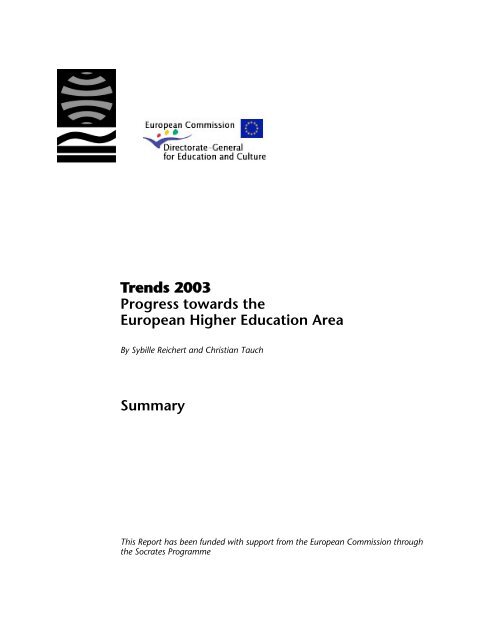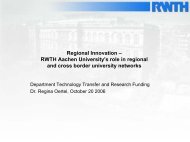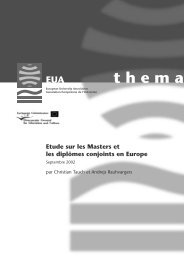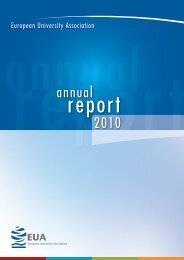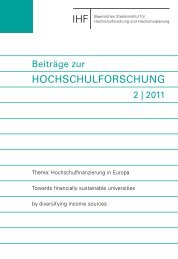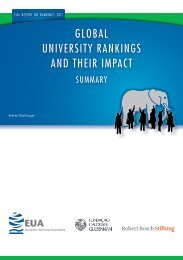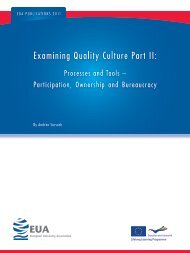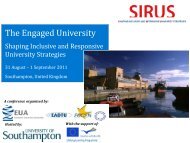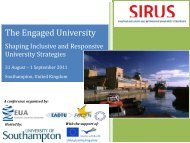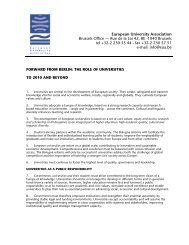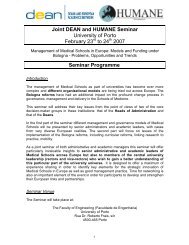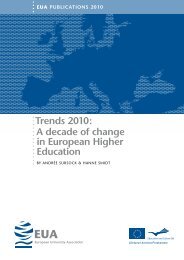Trends 2003 Progress towards the European Higher Education Area ...
Trends 2003 Progress towards the European Higher Education Area ...
Trends 2003 Progress towards the European Higher Education Area ...
You also want an ePaper? Increase the reach of your titles
YUMPU automatically turns print PDFs into web optimized ePapers that Google loves.
<strong>Trends</strong> <strong>2003</strong><br />
<strong>Progress</strong> <strong>towards</strong> <strong>the</strong><br />
<strong>European</strong> <strong>Higher</strong> <strong>Education</strong> <strong>Area</strong><br />
By Sybille Reichert and Christian Tauch<br />
Summary<br />
This Report has been funded with support from <strong>the</strong> <strong>European</strong> Commission through<br />
<strong>the</strong> Socrates Programme
Executive Summary<br />
Aims of <strong>the</strong> study<br />
This study aims to capture <strong>the</strong> most important recent trends related to <strong>the</strong> Bologna reforms. It is a<br />
follow-up to <strong>the</strong> two <strong>Trends</strong> reports which were written for <strong>the</strong> Bologna Conference in 1999 and<br />
<strong>the</strong> Prague Conference in 2001. Unlike <strong>the</strong> two first reports, which were mainly based on<br />
information provided by <strong>the</strong> Ministries of <strong>Higher</strong> <strong>Education</strong> and <strong>the</strong> Rectors’ Conferences,<br />
<strong>Trends</strong> <strong>2003</strong> tries to reflect not only <strong>the</strong>se two perspectives but also those of students, employers<br />
and, most importantly, <strong>the</strong> HEIs <strong>the</strong>mselves, thus giving a fairly comprehensive picture of <strong>the</strong><br />
present phase of <strong>the</strong> Bologna Process. If <strong>the</strong> EHEA is to become a reality, it has to evolve from<br />
governmental intentions and legislation to institutional structures and processes, able to provide<br />
for <strong>the</strong> intense exchange and mutual cooperation necessary for such a cohesive area. This means<br />
that higher education institutions are heavily and directly involved in <strong>the</strong> development of viable<br />
interpretations of concepts which were and are sometimes still vague, even in <strong>the</strong> minds of those<br />
who use <strong>the</strong>se concepts most often. Concrete meaning needs to be given to:<br />
ÿ <strong>the</strong> term "employability" in <strong>the</strong> context of study programmes at Bachelor level;<br />
ÿ <strong>the</strong> relation between <strong>the</strong> new two tiers;<br />
ÿ workload-based credits as units to be accumulated within a given programme;<br />
ÿ curricular design that takes into account qualification descriptors, level descriptors, skills<br />
and learning outcomes;<br />
ÿ <strong>the</strong> idea of flexible access and individualised learning paths for an increasingly diverse<br />
student body;<br />
ÿ <strong>the</strong> role of <strong>Higher</strong> <strong>Education</strong> inserting itself into a perspective of lifelong learning;<br />
ÿ <strong>the</strong> conditions needed to optimise access to mobility; and last but not least, to<br />
ÿ meaningful internal and external quality assurance procedures.<br />
We may thus assert from <strong>the</strong> outset that this study emphasises <strong>the</strong> need for complementarity<br />
between <strong>the</strong> top-down approach applied so far in <strong>the</strong> Bologna Process, with <strong>the</strong> emerging bottomup<br />
process in which higher education institutions are already playing and should continue to play<br />
a key role - as expected of <strong>the</strong>m by <strong>the</strong> ministers when <strong>the</strong>y first met in Bologna. Institutional<br />
developments in line with <strong>the</strong> objectives of <strong>the</strong> Bologna Process are not only emerging rapidly,<br />
but also represent challenges worthy of our full attention, as this study hopes to prove.<br />
2
Awareness and support of <strong>the</strong> Bologna Process<br />
Awareness of <strong>the</strong> Bologna Process has increased considerably during <strong>the</strong> last two years.<br />
Never<strong>the</strong>less, <strong>the</strong> results of <strong>the</strong> <strong>Trends</strong> <strong>2003</strong> survey and many o<strong>the</strong>r sources suggest that, despite<br />
this growing awareness among <strong>the</strong> different HE groups, <strong>the</strong> reforms have yet to reach <strong>the</strong><br />
majority of <strong>the</strong> HE grass-roots representatives who are supposed to implement <strong>the</strong>m and give<br />
<strong>the</strong>m concrete meaning. Deliberations on <strong>the</strong> implementation of Bologna reforms currently<br />
involve heads of institutions more than <strong>the</strong> academics <strong>the</strong>mselves. Hence, interpreting Bologna in<br />
<strong>the</strong> light of its goals and <strong>the</strong> whole context of its objectives at departmental level, i.e. rethinking<br />
current teaching structures, units, methods, evaluation and <strong>the</strong> permeability between disciplines<br />
and institutions, is a task that still lies ahead for a majority of academics at <strong>European</strong> universities.<br />
Administrative staff and students seem so far to be even less included in deliberations on <strong>the</strong><br />
implementation of Bologna reforms. Generally, awareness is more developed at universities than<br />
at o<strong>the</strong>r higher education institutions. In Estonia, Lithuania, Sweden, Germany, Ireland and most<br />
strongly <strong>the</strong> UK, deliberations on institutional Bologna reforms are even less widespread than in<br />
<strong>the</strong> o<strong>the</strong>r Bologna signatory countries. This does not mean, of course, that no reforms are being<br />
undertaken, but that if <strong>the</strong>re are reforms <strong>the</strong>y are not explicitly associated with <strong>the</strong> Bologna<br />
Process. In <strong>the</strong> case of Sweden, for instance, reforms along <strong>the</strong> lines of <strong>the</strong> Bologna Process are<br />
often not carried out in <strong>the</strong> name of Bologna.<br />
In <strong>the</strong> light of <strong>the</strong> scope of <strong>the</strong> Bologna reforms, which involve not only all disciplines but<br />
different groups of actors in <strong>the</strong> whole institution, it should be noted that only 47% of universities<br />
and only 29,5% of o<strong>the</strong>r HEIs have created <strong>the</strong> position of a Bologna coordinator.<br />
There is however widespread support for <strong>the</strong> Bologna Process among heads of HEIs. More<br />
than two thirds of <strong>the</strong> heads of institutions regard it as essential to make rapid progress <strong>towards</strong><br />
<strong>the</strong> EHEA, ano<strong>the</strong>r 20% support <strong>the</strong> idea of <strong>the</strong> EHEA but think <strong>the</strong> time is not yet ripe for it.<br />
However, some resistance to individual aspects and <strong>the</strong> pace of <strong>the</strong> reforms obviously remains.<br />
Such resistance seems to be more pronounced in Norway, France, <strong>the</strong> French-speaking<br />
community of Belgium, Germany, Hungary, Portugal, Ireland and <strong>the</strong> UK. Though some South<br />
East <strong>European</strong> (SEE) countries have not yet formally joined <strong>the</strong> Bologna Process, <strong>the</strong>y already<br />
take it as a reference framework and actively promote its objectives.<br />
The role of HEI in <strong>the</strong> Bologna Process<br />
While being mostly supportive of <strong>the</strong> Bologna process, 62 % of university rectors and 57% of<br />
heads of o<strong>the</strong>r HEIs in Europe feel that institutions should be involved more directly in <strong>the</strong><br />
realisation of <strong>the</strong> Bologna objectives.<br />
3
Moreover, 46% of HEI leaders find that <strong>the</strong>ir national legislation undermines autonomous<br />
decision-making - at least in part. Particularly in Belgium, Denmark, France, Germany, Greece,<br />
Hungary, Poland, Portugal, <strong>the</strong> Slovak Republic, Slovenia, Spain, Sweden and SEE, higher<br />
education representatives and rectors' conferences point to <strong>the</strong> limits of autonomous decisionmaking<br />
by institutions.<br />
While many governments have made considerable progress with respect to <strong>the</strong> creation of legal<br />
frameworks which allow HEIs to implement Bologna reforms, only half of <strong>the</strong>m seem to have<br />
provided some funding to <strong>the</strong> HEIs for <strong>the</strong>se reforms. The lack of financial support for <strong>the</strong><br />
Bologna reforms is highlighted by nearly half of all HEIs of <strong>the</strong> Bologna signatory<br />
countries. This means that <strong>the</strong> Bologna reforms are often implemented at <strong>the</strong> cost of o<strong>the</strong>r core<br />
functions or essential improvements. 75% of all heads of HEIs think clear financial incentives for<br />
involvement in <strong>the</strong> Bologna reforms should be provided. Obviously, <strong>the</strong> dialogue between rectors<br />
and academics, institutions and ministry representatives has to be intensified, beyond <strong>the</strong> reform<br />
of legislation, including both <strong>the</strong> implications of Bologna reforms at institutional level and <strong>the</strong><br />
State support needed to foster <strong>the</strong>se reforms, without detriment to o<strong>the</strong>r core functions of higher<br />
education provision.<br />
The role of students in <strong>the</strong> Bologna Process<br />
At 63% of universities in Bologna signatory countries, students have been formally involved in<br />
<strong>the</strong> Bologna Process, through participation in <strong>the</strong> senate or council or at faculty/departmental<br />
level. The same trend is valid for <strong>the</strong> non-signatory countries in SEE.<br />
A significantly lower degree of formal participation in <strong>the</strong> Bologna Process at institutional level<br />
can be noted in Greece, Portugal, Slovenia, Iceland and <strong>the</strong> UK. Half of <strong>the</strong> students, as<br />
represented by <strong>the</strong>ir national and <strong>European</strong> student associations, feel <strong>the</strong>y are playing a very or<br />
reasonably active role in <strong>the</strong> construction of <strong>the</strong> <strong>European</strong> <strong>Higher</strong> <strong>Education</strong> <strong>Area</strong>. At institutional<br />
and particularly at departmental level, <strong>the</strong> inclusion of students in <strong>the</strong> deliberations concerning a<br />
qualitative reform of teaching and learning structures, methods and evaluation in <strong>the</strong> spirit of <strong>the</strong><br />
Bologna declaration still leaves considerable room for improvement.<br />
Student representatives express <strong>the</strong> highest hopes concerning <strong>the</strong> principles of <strong>the</strong> Bologna<br />
reforms and <strong>the</strong> harshest criticism concerning <strong>the</strong>ir implementation and frequently reductive<br />
interpretations. The students' contribution to <strong>the</strong> deliberations on <strong>the</strong> Bologna reforms has been<br />
particularly strong on issues of <strong>the</strong> social dimension of <strong>Higher</strong> <strong>Education</strong> and <strong>the</strong> emphasis of HE<br />
as a public good, and in connection with discussions of <strong>the</strong> possible consequences of GATS on<br />
<strong>Higher</strong> <strong>Education</strong> Institutions. Students have also continuously stressed <strong>the</strong> values of studentcentred<br />
learning, flexible learning paths and access, as well as a realistic, i.e. empirically-based,<br />
estimation of work load in <strong>the</strong> context of establishing institution-wide credit systems.<br />
4
Academic quality and graduate employability as compatible aims<br />
Enhancing academic quality and <strong>the</strong> employability of graduates are <strong>the</strong> two most frequently<br />
mentioned driving forces behind <strong>the</strong> Bologna process according to <strong>the</strong> representatives of<br />
ministries, rectors' conferences and higher education institutions.<br />
A remarkable consensus has been reached at institutional level on <strong>the</strong> value of <strong>the</strong> employability<br />
of HE graduates in Europe: 91% of <strong>the</strong> heads of <strong>European</strong> higher education institutions regard <strong>the</strong><br />
employability of <strong>the</strong>ir graduates to be an important or even very important concern when<br />
designing or restructuring <strong>the</strong>ir curricula. However, regular and close involvement of<br />
professional associations and employers in curricular development still seems to be ra<strong>the</strong>r<br />
limited. HEIs should be encouraged to seek a close dialogue with professional associations and<br />
employers in reforming <strong>the</strong>ir curricula. However, fears of short-sighted misunderstandings of <strong>the</strong><br />
ways in which higher education should aim at employability and relevance to society and <strong>the</strong><br />
economy have re-emerged frequently in <strong>the</strong> context of comparing and redesigning modules or<br />
degree structures. To do justice to <strong>the</strong> concerns of stakeholders regarding <strong>the</strong> relevance of higher<br />
education and <strong>the</strong> employability of HE graduates, without compromising <strong>the</strong> more long-term<br />
perspective proper to higher education institutions and to universities in particular, may well be<br />
<strong>the</strong> most decisive challenge and success-factor of Bologna-related curricular reforms. It should be<br />
noted that <strong>the</strong> growing trend <strong>towards</strong> structuring curricula in function of <strong>the</strong> learning outcomes<br />
and competences, is often seen as a way to ensure that academic quality and long-term<br />
employability become compatible goals of higher education. This understanding has also been<br />
<strong>the</strong> basis for <strong>the</strong> project "Tuning <strong>Education</strong>al Structures in Europe" in which more than 100<br />
universities have tried to define a common core of learning outcomes in a variety of disciplines.<br />
Promotion of mobility in Europe<br />
While outgoing and incoming student mobility has increased across Europe, incoming mobility<br />
has grown more in <strong>the</strong> EU than in <strong>the</strong> accession countries. A majority of institutions report an<br />
imbalance of outgoing over incoming students. Net importers of students are most often<br />
located in France, The Ne<strong>the</strong>rlands, Denmark, Sweden and, most strongly, in Ireland or <strong>the</strong> UK<br />
where 80% of <strong>the</strong> institutions report an imbalance of incoming over outgoing students.<br />
Teaching staff mobility has increased over <strong>the</strong> last three years at a majority of higher education<br />
institutions in more than two thirds of <strong>the</strong> signatory countries.<br />
Public funds for mobility have been increased in <strong>the</strong> majority of EU countries but only in a<br />
minority of accession countries. However, <strong>the</strong> number and level of mobility grants for students is<br />
5
not sufficient to allow for equal access to mobility for those from financially less privileged<br />
backgrounds.<br />
Comparable and <strong>European</strong>-wide data on all mobility (including free movers), including<br />
students' financial and social conditions, is urgently needed in order to allow monitoring of any<br />
progress in <strong>European</strong> mobility and benchmarking with o<strong>the</strong>r regions in <strong>the</strong> world.<br />
Attractiveness of <strong>the</strong> EHEA and <strong>the</strong> national higher education systems<br />
Enhancing <strong>the</strong> attractiveness of <strong>the</strong> <strong>European</strong> systems of <strong>Higher</strong> <strong>Education</strong> in <strong>the</strong> non-<strong>European</strong><br />
world is a third driving force of <strong>the</strong> Bologna Process, ranked by <strong>Trends</strong> III respondents after<br />
improving academic quality and preparing graduates for a <strong>European</strong> labour market. The EU is<br />
by far <strong>the</strong> highest priority area for most institutions (mentioned by 92%). The second priority<br />
area is Eastern Europe (62%), followed by US/Canada (57%), Asia (40%), Latin America (32%),<br />
Africa and Australia (24% and 23%) and <strong>the</strong> Arab World (16%). In some <strong>European</strong> countries, <strong>the</strong><br />
priorities diverge considerably from this ranking, notably in <strong>the</strong> UK, Spain, Germany and<br />
Romania where Europe is targeted significantly less often.<br />
In order to promote <strong>the</strong>ir attractiveness in <strong>the</strong>se priority areas, joint programmes or similar cooperation<br />
activities are clearly <strong>the</strong> preferred instrument (mentioned by three quarters of all HEIs).<br />
Only 30% of HEIs mention <strong>the</strong> use of targeted marketing for recruiting students, with <strong>the</strong><br />
notable exceptions of Ireland and <strong>the</strong> UK where more than 80% of universities conduct targeted<br />
marketing.<br />
A majority of countries have developed national brain drain prevention and brain gain promotion<br />
policies. Most HEIs still have to define <strong>the</strong>ir own institutional profiles more clearly in order to be<br />
able to target <strong>the</strong> markets which correspond to <strong>the</strong>ir priorities. In light of <strong>the</strong> competitive arena of<br />
international student recruitment, HEIs will not be able to avoid targeted marketing techniques if<br />
<strong>the</strong>y want to position <strong>the</strong>mselves internationally, even if such efforts may go against <strong>the</strong> grain of<br />
established academic culture and habits.<br />
<strong>Higher</strong> <strong>Education</strong> as a public good<br />
A large consensus appears to exist in <strong>the</strong> emerging EHEA regarding <strong>Higher</strong> <strong>Education</strong> as a<br />
public good and a public responsibility. It is widely recognised that social and financial support<br />
schemes, including portable grants and loans, and improved academic and social counselling are<br />
conditions for wider access to higher education, more student mobility and improved graduation<br />
rates.<br />
6
However, <strong>the</strong> conflict between cooperation and solidarity, on <strong>the</strong> one hand, and competition and<br />
concentration of excellence, on <strong>the</strong> o<strong>the</strong>r, is currently growing as HEIs are faced with decreasing<br />
funds. <strong>Higher</strong> education institutions can try to combine widened access, diversified provision and<br />
concentration of excellence, but often have to pursue one option to <strong>the</strong> detriment of <strong>the</strong> o<strong>the</strong>rs. In<br />
competing with o<strong>the</strong>r policy areas for public funding, HEIs still have to convince parliaments and<br />
governments of <strong>the</strong> vital contribution of HE graduates and HE-based research to social and<br />
economic welfare.<br />
<strong>Higher</strong> <strong>Education</strong> in <strong>the</strong> GATS<br />
Only one third of <strong>the</strong> Ministries have developed a policy on <strong>the</strong> position of <strong>Higher</strong> <strong>Education</strong> in<br />
<strong>the</strong> World Trade Organisation's General Agreement on Trade in Services (GATS), while<br />
two thirds have not. The situation is similar for <strong>the</strong> Rectors’ Conferences. Only 20% of HEI<br />
leaders declared <strong>the</strong>mselves to be fully aware of <strong>the</strong> GATS negotiations, almost half of <strong>the</strong>se<br />
leaders considered <strong>the</strong>mselves to be aware without having specific details, and 29% said <strong>the</strong>y<br />
were not yet aware of GATS, with considerable differences between countries.<br />
Students’ associations seem to be well aware of GATS and <strong>the</strong> threats posed by <strong>the</strong> fur<strong>the</strong>r<br />
inclusion of HE in <strong>the</strong> on-going negotiations. There is a consensus that more transparency and<br />
consultation of higher education representatives is needed in <strong>the</strong> ongoing and future GATS<br />
negotiations.<br />
To meet <strong>the</strong> internationalisation challenges, <strong>the</strong>re is a growing need for enhanced quality<br />
assurance procedures and regulatory frameworks, also given <strong>the</strong> emergence of many private forprofit<br />
institutions in Europe.<br />
Degree structures, qualification frameworks and curricula<br />
Regarding <strong>the</strong> introduction of study structures based on undergraduate and graduate tiers,<br />
important progress has been made in legal terms. Today, 80% of <strong>the</strong> Bologna countries ei<strong>the</strong>r<br />
have <strong>the</strong> legal possibility to offer two-tier structures or are introducing <strong>the</strong>se. Many<br />
governments have fixed deadlines for <strong>the</strong> transition from <strong>the</strong> traditional to <strong>the</strong> new degree system.<br />
In <strong>the</strong> remaining 20% of countries, <strong>the</strong> necessary legislative changes are being prepared. The<br />
latter holds true also for SEE countries.<br />
As for <strong>the</strong> HEIs, 53% have introduced or are introducing <strong>the</strong> two-tier structure while 36% are<br />
planning it. In o<strong>the</strong>r words, almost 90% of HEIs in <strong>the</strong> Bologna countries have or will have a<br />
7
two-tier structure. Only 11% of HEIs see no need for curricular reform in this process. About<br />
55% of HEIs in SEE have not yet introduced <strong>the</strong> two-tier structure.<br />
The need for more structured doctoral studies in Europe has been highlighted repeatedly in recent<br />
years. The traditional procedure of leaving doctoral students largely on <strong>the</strong>ir own and providing<br />
<strong>the</strong>m with individual supervision only is no longer suited to <strong>the</strong> challenges of modern society and<br />
hampers <strong>the</strong> realisation of <strong>the</strong> <strong>European</strong> <strong>Higher</strong> <strong>Education</strong> <strong>Area</strong>.<br />
Europe is divided in two halves regarding <strong>the</strong> organisation of <strong>the</strong>se third-tier doctoral studies. In<br />
half of <strong>the</strong> countries, doctoral students receive mainly individual supervision and tutoring, while<br />
in <strong>the</strong> o<strong>the</strong>r half, taught doctoral courses are also offered in addition to individual work. HEIs still<br />
face <strong>the</strong> challenge of how to cooperate, with <strong>the</strong> support of governments, at doctoral level<br />
nationally and across Europe, and whe<strong>the</strong>r or not this should involve <strong>the</strong> setting-up of<br />
structured doctoral studies, particularly in interdisciplinary and international settings.<br />
Student support for <strong>the</strong> new degree structures clearly outweighs <strong>the</strong> reservations, but <strong>the</strong> risk of<br />
putting too much emphasis on “employability” still causes unease among a substantial number of<br />
student associations.<br />
In countries where first degrees at Bachelor level have not existed in <strong>the</strong> past, <strong>the</strong>re still appears<br />
to be a tendency to see <strong>the</strong>se as a stepping stone or orientation platform, ra<strong>the</strong>r than as degrees in<br />
<strong>the</strong>ir own right. The perception of Bachelor degrees as valid and acceptable qualifications still<br />
leaves room for improvement.<br />
Governments and HEIs will have to cooperate closely to ensure that <strong>the</strong> implementation of <strong>the</strong><br />
new degree structures is not done superficially, but is accompanied by <strong>the</strong> necessary curricular<br />
review, taking into account not only <strong>the</strong> ongoing <strong>European</strong> discussions on descriptors for<br />
Bachelor-level and Master-level degrees, learning outcomes and qualification profiles, but also<br />
institution-specific needs for curricular reform.<br />
To achieve <strong>the</strong> objective of a “system of easily readable and comparable degrees” within <strong>the</strong><br />
<strong>European</strong> <strong>Higher</strong> <strong>Education</strong> <strong>Area</strong>, it will be essential that governments and HEIS use <strong>the</strong> next<br />
phase of <strong>the</strong> Bologna Process to elaborate qualifications frameworks based on external<br />
reference points (qualification descriptors, level descriptors, skills and learning outcomes),<br />
possibly in tune with a common <strong>European</strong> Qualifications Framework. The outcomes of <strong>the</strong><br />
Joint Quality Initiative and <strong>the</strong> Tuning project may be relevant in this respect.<br />
Joint Curricula and Joint Degrees<br />
Joint Curricula and Joint Degrees are intrinsically linked to all <strong>the</strong> objectives of <strong>the</strong> Bologna<br />
Process and have <strong>the</strong> potential to become an important element of a truly <strong>European</strong> <strong>Higher</strong><br />
<strong>Education</strong> <strong>Area</strong>. Never<strong>the</strong>less, and in spite of <strong>the</strong> appeal in <strong>the</strong> Prague Communiqué, Joint<br />
8
Curricula and Joint Degrees still do not receive sufficient attention, as is confirmed by <strong>the</strong> fact<br />
that most Ministries and Rectors’ Conferences attach only medium or even low importance to<br />
<strong>the</strong>se. More than two thirds of <strong>the</strong> Ministries claim to give some kind of financial incentive to <strong>the</strong><br />
development of Joint Curricula/Joint Degrees but <strong>the</strong> extent of such support is not known.<br />
While support for Joint Curricula and Joint Degrees is clearly higher among HEIs and students,<br />
<strong>the</strong>se have not yet been recognised as core tools for institutional development. Their creation and<br />
coordination still appears to be left entirely to <strong>the</strong> initiative of individual professors.<br />
HEIs and national higher education systems in <strong>the</strong> EHEA would lose an enormous opportunity to<br />
position <strong>the</strong>mselves internationally if <strong>the</strong>y were not to focus <strong>the</strong>ir attention more than before on<br />
systematic – including financial - support for <strong>the</strong> development of Joint Curricula/Joint Degrees.<br />
Of course, such support would entail amendments and changes in <strong>the</strong> existing higher education<br />
legislation of many countries, as in more than half of <strong>the</strong> Bologna Process countries, <strong>the</strong><br />
legislation does not yet allow <strong>the</strong> awarding of Joint Degrees. It would also call for <strong>the</strong><br />
elaboration of agreed guidelines and definitions for Joint Curricula/Joint Degrees, both at<br />
national and <strong>European</strong> level, and would rely on enhanced networking between <strong>the</strong> HEIs<br />
<strong>the</strong>mselves.<br />
Recognition<br />
About two thirds of <strong>the</strong> Bologna signatory countries have so far ratified <strong>the</strong> most important<br />
legal tool for recognition, <strong>the</strong> Lisbon Recognition Convention. The <strong>European</strong> <strong>Higher</strong><br />
<strong>Education</strong> <strong>Area</strong> would benefit if this Convention were ratified by all Bologna signatory states as<br />
soon as possible.<br />
Correspondingly, more than half of <strong>the</strong> academic staff are reported as being not very aware or not<br />
aware at all of <strong>the</strong> provisions of <strong>the</strong> Lisbon Convention. Close cooperation with <strong>the</strong> relevant<br />
ENIC/NARIC is reported by only 20% of HEIs, while 25% don’t cooperate at all with <strong>the</strong>ir<br />
ENIC/NARIC. A fur<strong>the</strong>r 28% of HEIs say <strong>the</strong>y do not know what ENIC/NARIC is (or at least<br />
not under this name).<br />
Thus awareness of <strong>the</strong> provisions of <strong>the</strong> Lisbon Convention, but also of <strong>the</strong> ENIC/NARIC<br />
initiatives (recognition procedures in transnational education etc.) among academic staff<br />
and students needs to be raised, through cooperation between international organisations,<br />
national authorities and HEIs. Moreover, <strong>the</strong> position of <strong>the</strong> ENIC/NARIC also needs to be<br />
streng<strong>the</strong>ned in some countries.<br />
Two thirds of <strong>the</strong> Ministries, more than half of <strong>the</strong> HEIs and slightly less than 50% of <strong>the</strong> student<br />
associations expect that <strong>the</strong> Bologna Process will greatly facilitate academic recognition<br />
procedures. While HEIs are ra<strong>the</strong>r optimistic with regard to <strong>the</strong> smoothness of recognition<br />
9
procedures of study abroad periods, in many countries, however, institution-wide procedures for<br />
recognition seem to be quite under-developed, and <strong>the</strong> recognition of study abroad periods often<br />
takes place on a case-by-case basis. Even where formal procedures exist, students, as <strong>the</strong><br />
primarily concerned group, often say <strong>the</strong>y are unaware of <strong>the</strong>se. Almost 90% of <strong>the</strong> students’<br />
associations reported that <strong>the</strong>ir members occasionally or often encounter recognition problems<br />
when <strong>the</strong>y return from study abroad.<br />
It is a positive sign that more than 40% of <strong>the</strong> students’ associations indicated that appeal<br />
procedures for recognition problems were also in place in <strong>the</strong>ir members’ institutions. But,<br />
clearly, more HEIs should be encouraged to develop more and better institutional recognition<br />
procedures, and especially to intensify communication with students on <strong>the</strong>se matters.<br />
The Diploma Supplement is being introduced in a growing number of countries, but <strong>the</strong> main<br />
target group - <strong>the</strong> employers - is still insufficiently aware of it. Awareness of <strong>the</strong> potential<br />
benefits of <strong>the</strong> Diploma Supplement <strong>the</strong>refore also needs to be raised. The introduction of a<br />
Diploma Supplement label (like that of an ECTS label) would probably lead to a clear qualitative<br />
improvement in <strong>the</strong> use of <strong>the</strong> Diploma Supplement.<br />
Credits for transfer and accumulation<br />
ECTS is clearly emerging as <strong>the</strong> <strong>European</strong> credit system. In many countries it has become a legal<br />
requirement, while o<strong>the</strong>r countries with national credit systems are ensuring <strong>the</strong>ir compatibility<br />
with ECTS.<br />
Two thirds of HEIs today use ECTS for credit transfer,15% use a different system. Regarding<br />
credit accumulation, almost three quarters of HEIs declare that <strong>the</strong>y have already introduced it –<br />
this surprisingly high figure needs fur<strong>the</strong>r examination and may result from an insufficient<br />
understanding of <strong>the</strong> particularities of a credit accumulation system.<br />
The ECTS information campaign of <strong>the</strong> past years, undertaken by <strong>the</strong> <strong>European</strong> Commission, <strong>the</strong><br />
<strong>European</strong> University Association and many national organisations, has yet to reach a majority of<br />
institutions where <strong>the</strong> use of ECTS is still not integrated into institution-wide policies or<br />
guidelines, and its principles and tools are often insufficiently understood<br />
The basic principles and tools of ECTS, as laid down in <strong>the</strong> "ECTS Key Features" document,<br />
need to be conveyed to academic and administrative staff and students alike in order to exploit<br />
<strong>the</strong> potential of ECTS as a tool for transparency. Support and advice is particularly needed<br />
regarding credit allocation related to learning outcomes, workload definition, and <strong>the</strong> use of<br />
ECTS for credit accumulation. The introduction of <strong>the</strong> ECTS label will lead to a clear qualitative<br />
improvement in <strong>the</strong> use of ECTS.<br />
10
Autonomy and Quality Assurance<br />
Increasing autonomy normally means greater independence from state intervention, but is<br />
generally accompanied by a growing influence of o<strong>the</strong>r stakeholders in society, as well as by<br />
extended external quality assurance procedures and outcome-based funding mechanisms.<br />
However, many higher education representatives stress that a release of higher education<br />
institutions from state intervention will only increase institutional autonomy and optimise <strong>the</strong><br />
universities' innovative potential, as long as this is not undone by mechanistic and uniform ex<br />
post monitoring of outputs, or by an overly intrusive influence of o<strong>the</strong>r stakeholders with more<br />
short-term perspectives.<br />
All Bologna signatory countries have established or are in <strong>the</strong> process of establishing agencies<br />
which are responsible for external quality control in some form or ano<strong>the</strong>r. 80% of HEIs in<br />
Europe already undergo external quality assurance procedures in some form or ano<strong>the</strong>r (quality<br />
evaluation or accreditation). The previous opposition between accreditation procedures in <strong>the</strong><br />
accession countries and quality evaluation in EU countries seems to be softening: A growing<br />
interest in accreditation and <strong>the</strong> use of criteria and standards can be observed in Western Europe,<br />
while an increasing use of improvement-oriented evaluation procedures is noted in Eastern<br />
<strong>European</strong> countries. Two recent comparative studies also observe a softening of opposition<br />
between institution- and programme-based approaches among QA agencies and an increasing<br />
mix of <strong>the</strong>se two approaches within <strong>the</strong> same agencies.<br />
The primary function of external quality assurance (quality evaluation or accreditation),<br />
according to <strong>the</strong> responsible agencies and <strong>the</strong> majority of HEIs, consists in quality<br />
improvement. Only in France, Slovakia and <strong>the</strong> UK, accountability to society is mentioned more<br />
frequently than quality improvement. Even accreditation agencies, traditionally more oriented<br />
toward accountability, have stressed improvement in recent years. Generally speaking, external<br />
quality procedures are evaluated positively by <strong>the</strong> HEIs. Most frequently, <strong>the</strong>y are regarded as<br />
enhancing institutional quality culture. <strong>Higher</strong> education representatives, however, often observe<br />
that <strong>the</strong> effectiveness of <strong>the</strong> quality evaluation procedures will depend to a large extent on <strong>the</strong>ir<br />
readiness to consider <strong>the</strong> links between teaching and research and o<strong>the</strong>r dimensions of<br />
institutional management. As complex systems, universities cannot react to a problem seen in one<br />
domain without also affecting o<strong>the</strong>r domains indirectly. Likewise, <strong>the</strong> efficiency and return on<br />
investment in quality review processes will depend on <strong>the</strong> synergies and coordination between<br />
<strong>the</strong> various national and <strong>European</strong> accountability and quality assurance procedures, as well as <strong>the</strong><br />
funding mechanisms in place across Europe.<br />
Internal quality assurance procedures seem to be just as widespread as external ones and<br />
mostly focus on teaching. 82% of <strong>the</strong> heads of HEIs reported that <strong>the</strong>y have internal procedures<br />
to monitor <strong>the</strong> quality of teaching, 53% also have internal procedures to monitor <strong>the</strong> quality of<br />
11
esearch. Only a quarter of <strong>the</strong> HEIs say <strong>the</strong>y have procedures to monitor aspects o<strong>the</strong>r than<br />
teaching and research. At <strong>the</strong> moment, however, internal procedures are not yet developed and<br />
robust enough to make external quality assurance superflous.<br />
Ministries, rectors' conferences, HEIs, and students all generally prefer mutual recognition of<br />
national quality assurance procedures over common <strong>European</strong> structures. However, <strong>the</strong><br />
objects and beneficiaries (or "victims") of quality evaluation and accreditation, <strong>the</strong> higher<br />
education institutions <strong>the</strong>mselves, are significantly more positively disposed toward common<br />
structures and procedures than <strong>the</strong> national actors. For instance, nearly half of higher education<br />
institutions say <strong>the</strong>y would welcome a pan-<strong>European</strong> accreditation agency.<br />
The ultimate challenge for QA in Europe consists in creating transparency, exchange of good<br />
practice and enough common criteria to allow for mutual recognition of each o<strong>the</strong>rs' procedures,<br />
without mainstreaming <strong>the</strong> system and undermining its positive forces of diversity and<br />
competition.<br />
Lifelong learning<br />
Definitions of Lifelong Learning (LLL) and its relation to Continuing <strong>Education</strong> (CE) and Adult<br />
<strong>Education</strong> are still vague and diverse in different national contexts. Generally speaking, as far as<br />
<strong>the</strong> HE sector is concerned, LLL debates constitute <strong>the</strong> follow-up to <strong>the</strong> older debates on<br />
Continuing <strong>Education</strong> and Adult <strong>Education</strong>, sharing <strong>the</strong>ir focus on flexible access to <strong>the</strong> courses<br />
provided, as well as <strong>the</strong> attempt to respond to <strong>the</strong> diverse profiles and backgrounds of students.<br />
All of <strong>the</strong> recent definitions of LLL reflect an emphasis on identifying how learning can best be<br />
enabled, in all contexts and phases of life.<br />
The need for national LLL policies seems to be undisputed, and was strongly pushed in <strong>the</strong><br />
context of <strong>the</strong> consultation on <strong>the</strong> <strong>European</strong> Commission's Memorandum on LLL (November<br />
2000). The <strong>Trends</strong> <strong>2003</strong> survey reveals that in <strong>2003</strong> <strong>the</strong> majority of countries ei<strong>the</strong>r intend or are<br />
in <strong>the</strong> process of developing a LLL strategy. Such policies already exist in one third of Bologna<br />
signatory countries, namely in Belgium, Denmark, Finland, France, Iceland, Ireland, The<br />
Ne<strong>the</strong>rlands, Norway, Poland, Slovakia, Sweden and <strong>the</strong> UK.<br />
Most of <strong>the</strong> policies and actions undertaken at <strong>European</strong> and national levels do not target <strong>the</strong><br />
higher education sector as such, and do not address <strong>the</strong> particular added value or conditions of<br />
LLL provision at HEIs.<br />
At institutional level, <strong>the</strong> UK, Iceland, France, <strong>the</strong> Czech Republic, <strong>the</strong> Slovak Republic and<br />
Bulgaria have <strong>the</strong> highest percentages of higher education institutions with LLL strategies, while<br />
Germany, Austria, Italy, Hungary, Turkey, Romania and o<strong>the</strong>r SEE countries have <strong>the</strong> lowest<br />
percentages.<br />
12
A majority of student associations have observed changes in attitude to LLL over <strong>the</strong> last three<br />
years at institutions in <strong>the</strong>ir countries. Nearly half of <strong>the</strong> student representatives noted changes<br />
with respect to <strong>the</strong> courses offered to non-traditional students, while a third observed greater<br />
encouragement of LLL culture among students. Little change was observed with respect to<br />
teaching methodologies or access policies.<br />
Most national LLL policies comprise two co-existing agenda of social inclusion, stressing<br />
flexible access and diversity of criteria for different learner profiles, and economic<br />
competitiveness, focusing on efficient up-dating of professional knowledge and skills. The latter<br />
dimension is often funded and developed in partnership with labour market stakeholders. If <strong>the</strong><br />
competitiveness agenda is reinforced by tight national budgets and not counterbalanced by<br />
government incentives, university provision of LLL may well be forced to let go of <strong>the</strong> more<br />
costly social agenda.<br />
The development of LLL provision reflects a clear market orientation and a well-developed<br />
dialogue with stakeholders. Two thirds of <strong>the</strong> <strong>European</strong> institutions provide assistance on request<br />
and respond to <strong>the</strong> expressed needs of businesses, professional associations and o<strong>the</strong>r employers.<br />
Nearly half (49%) actually initiate joint programmes, with considerably more institutions doing<br />
so in Finland, Iceland, Sweden, Norway, Estonia, France, Ireland and <strong>the</strong> UK. However, <strong>the</strong><br />
inclination to respond directly to market needs is also one of <strong>the</strong> reasons for <strong>the</strong> critical attitude of<br />
many academics toward LLL units at higher education institutions, especially at universities.<br />
<strong>European</strong> reforms of degree structures seem to affect LLL at many institutions. 39% of heads of<br />
institutions find that <strong>the</strong> implementation of new degree structures also affects <strong>the</strong> design of LLL<br />
programmes and modules.<br />
With <strong>the</strong> exception of exchanging experience in major <strong>European</strong> networks of continuing<br />
education, <strong>European</strong> cooperation between institutions in LLL, e.g. for <strong>the</strong> sake of joint course<br />
development, is still <strong>the</strong> exception ra<strong>the</strong>r than <strong>the</strong> rule.<br />
LLL provision is still generally marginalised, i.e. rarely integrated in <strong>the</strong> general strategies, core<br />
processes and decision-making of <strong>the</strong> institution. Even in those countries where CE or LLL has<br />
been playing an important political role and where incentives are provided to develop LLL, such<br />
as France, <strong>the</strong> UK and Finland, CE centers are not always recognised on an equal footing with <strong>the</strong><br />
rest of university teaching and research. In order to position <strong>the</strong>mselves in an expanding market<br />
and clarify <strong>the</strong> added value of <strong>the</strong>ir expertise, HEIs will have to make more of an effort to<br />
integrate LLL into <strong>the</strong>ir core development processes and policies.<br />
13
Diversification of institutional profiles<br />
Currently, a large majority of <strong>European</strong> higher education institutions are alike in <strong>the</strong> relative<br />
weight <strong>the</strong>y attribute to teaching and research, and in <strong>the</strong> dominance of a national orientation<br />
regarding <strong>the</strong> community <strong>the</strong>y primarily serve. Only 13% of all <strong>European</strong> HEIs (16% of<br />
universities) see <strong>the</strong>mselves as serving a world-wide community (with large country divergences<br />
in this respect), while only 7% see <strong>the</strong>mselves as primarily serving a <strong>European</strong> community.<br />
<strong>Higher</strong> education institutions are facing an increasing need to develop more differentiated<br />
profiles, since <strong>the</strong> competition for public and private funds, as well as for students and staff, has<br />
increased in times of more intense internationalisation and even globalisation of parts of <strong>the</strong><br />
<strong>Higher</strong> <strong>Education</strong> market. However, <strong>the</strong> readiness of HEIs to develop more differentiated profiles<br />
depends to a large extent on increased autonomy - which is only partially realised in Europe, as<br />
well as on funding mechanisms which allow for such profiling, and which are not yet in place in<br />
any <strong>European</strong> country.<br />
A major challenge for <strong>the</strong> future consists in addressing <strong>the</strong> new needs which arise from <strong>the</strong><br />
diversified body of immediate partners in teaching and research. Universities will not only have<br />
to decide what <strong>the</strong> limits of <strong>the</strong>se partners' roles should be, in order to maintain <strong>the</strong>ir own<br />
academic freedom, but will also have to sell <strong>the</strong> 'unique added value' of what <strong>the</strong> university's role<br />
and contribution to teaching and research can be, distinguishing <strong>the</strong>mselves from o<strong>the</strong>r<br />
organisations which also offer teaching or research. Their learning structures and outcomes, with<br />
suitable supporting quality criteria, including <strong>the</strong>ir individual ways of relating academic quality<br />
to sustainable employability, will certainly become one of <strong>the</strong> prime ingredients of institutional<br />
positioning in Europe and <strong>the</strong> world.<br />
14
CONCLUSIONS: TOWARD SUSTAINABLE REFORMS OF HIGHER<br />
EDUCATION IN EUROPE?<br />
This study has looked at <strong>the</strong> Bologna Process from a predominantly institutional point of view. It<br />
has traced <strong>European</strong> and national trends pertaining to <strong>the</strong> overall Bologna goals and operational<br />
objectives, and has attempted to draw attention to implications, emerging consequences and<br />
possible interpretations of such developments at <strong>the</strong> level of higher education institutions. While<br />
concrete conclusions have already been drawn at <strong>the</strong> end of each individual section, we would<br />
like to emphasise four more fundamental conclusions which have emerged from <strong>the</strong> current phase<br />
of implementing <strong>the</strong> Bologna reforms at national and institutional levels, and which apply to any<br />
given ingredient of <strong>the</strong> reforms:<br />
1. HOLISTIC BOLOGNA<br />
Implementing <strong>the</strong> Bologna objectives becomes most fruitful if <strong>the</strong>y are taken as a package and<br />
related to each o<strong>the</strong>r. Thus, for instance, <strong>the</strong> links between creating a Bachelor/Master degree<br />
structure, establishing an institution-wide credit transfer and accumulation system, and, less<br />
obvious to some, opening a lifelong learning perspective, have clearly emerged as points of<br />
synergy in <strong>the</strong> course of reflections on how to implement such reforms at institutional level.<br />
These links have crystallised around <strong>the</strong> issues of creating modular structures and defining<br />
qualification frameworks and profiles, as well as concrete learning outcomes in terms of<br />
knowledge, competences and skills. O<strong>the</strong>r links were already clearly visible two years ago, such<br />
as <strong>the</strong> fact that creating compatible structures and improvement-oriented quality assurance would<br />
build trust and facilitate recognition, which in turn would facilitate mobility. In <strong>the</strong> course of<br />
devising viable academic solutions to some of <strong>the</strong> Bologna challenges, higher education<br />
representatives are now beginning to discover that, if given enough time, <strong>the</strong>y may have<br />
embarked on more far-reaching and meaningful reforms than <strong>the</strong>y had originally envisaged,<br />
enhancing attention to learners' needs as well as flexibility within and between degree<br />
programmes, institutions and national systems.<br />
2. SYSTEMIC BOLOGNA<br />
Implementing <strong>the</strong> Bologna objectives has far-reaching implications for <strong>the</strong> whole institution, not<br />
just in terms of reforming <strong>the</strong> teaching provision but also regarding counselling and o<strong>the</strong>r support<br />
services, infrastructure and, last but not least, university expenditure. Bologna reforms are not<br />
"cost-neutral"; <strong>the</strong>y imply initial investments as well as increased recurrent costs of provision<br />
which affect o<strong>the</strong>r core functions of <strong>the</strong> institutions if overall budgets do not increase in real<br />
terms. But <strong>the</strong> systemic integration of <strong>the</strong> Bologna reforms does not just assert itself in<br />
administrative, infrastructural and financial terms. It also becomes blatantly obvious in <strong>the</strong><br />
establishment of <strong>the</strong> new Bachelor and Master degrees, in which <strong>the</strong> role of research may have to<br />
be redefined. Master degrees, of course, cannot be reformed without due regard to <strong>the</strong>ir links and<br />
interrelation with doctoral-level teaching and research. To state <strong>the</strong> obvious, teaching cannot and<br />
should not be reformed at universities without considering its interrelation with research, from<br />
creating opportunities of recruiting young researchers to <strong>the</strong> integration of research projects into<br />
teaching.<br />
15
3. AMBIVALENT BOLOGNA<br />
In practically all action lines of <strong>the</strong> Bologna reforms, two potentially conflicting agenda emerge:<br />
On <strong>the</strong> one hand, <strong>the</strong>re is <strong>the</strong> competitiveness agenda, which aims at bracing institutions and<br />
national systems for global competition, using transparent structures and cooperation with<br />
<strong>European</strong> partners in order to survive or even thrive in an increasingly tough competition for<br />
funds, students and researchers. According to this agenda, greater concentration of excellence and<br />
centres of competence, clearer emphases of strengths and harsher treatment of weaknesses are<br />
necessary, even urgent, if <strong>European</strong> higher education is to contribute to reaching <strong>the</strong> lofty goal of<br />
Europe becoming "<strong>the</strong> most competitive dynamic knowledge-based economy in <strong>the</strong> world" by<br />
2010 (Lisbon 2000).<br />
On <strong>the</strong> o<strong>the</strong>r hand, <strong>the</strong>re is <strong>the</strong> social agenda, stressing cooperation and solidarity between equal<br />
and unequal partners, flexible access, attention to individuals and individual contexts, including<br />
addressing issues such as <strong>the</strong> dangers of brain drain. It would be naïve to assume that <strong>the</strong><br />
<strong>European</strong> <strong>Higher</strong> <strong>Education</strong> <strong>Area</strong> is being built only on <strong>the</strong> latter agenda.<br />
Both agenda are needed to fuel <strong>the</strong> process. But <strong>the</strong>y also have to be weighted, balanced and<br />
adapted to any given institutional context as well as interpreted in <strong>the</strong> light of each institution's<br />
attempts to find an appropriate niche in <strong>the</strong> national and <strong>European</strong> system of higher education.<br />
Well-meaning attempts to square <strong>the</strong> circle by trying to pursue both agenda, without any fur<strong>the</strong>r<br />
differentiation regarding <strong>the</strong>ir application to different parts of each given system or institution,<br />
are bound to kill <strong>the</strong> fragile emerging institutional profiles which can be witnessed in a number of<br />
<strong>European</strong> countries. In any case, national legislators, policy-makers and institutional leaders must<br />
try to avoid <strong>the</strong> considerable danger of creating contradictory policies, incentives or measures if<br />
<strong>the</strong>y want to succeed in ei<strong>the</strong>r or both of <strong>the</strong>se agenda. Instead, legislators and policy-makers<br />
should enlarge – and higher education institutions should use – <strong>the</strong> spaces for autonomous<br />
decision-making in order to allow for such differentiation.<br />
4. FURTHERING BOLOGNA<br />
So far, <strong>the</strong> Bologna Process has made considerable progress in achieving <strong>the</strong> objectives set out in<br />
1999. This study proves once again that <strong>the</strong>se objectives are realistic enough to inspire<br />
confidence in <strong>the</strong> developments leading to <strong>the</strong> <strong>European</strong> <strong>Higher</strong> <strong>Education</strong> <strong>Area</strong>. However, we<br />
should point to some neglected view-points and issues which seem to us to be essential for <strong>the</strong><br />
creation of a genuine <strong>European</strong> <strong>Higher</strong> <strong>Education</strong> <strong>Area</strong>:<br />
There seems to be a surprising lack of attention to <strong>the</strong> issue of facilitating a truly <strong>European</strong>-wide<br />
recruitment of professors. There are very few <strong>European</strong> higher education institutions which have<br />
a sizeable minority, let alone a majority, of non-national <strong>European</strong> academic staff. While this<br />
issue is addressed in <strong>the</strong> framework of <strong>the</strong> <strong>European</strong> Research <strong>Area</strong>, it belongs just as centrally to<br />
<strong>the</strong> creation of a <strong>European</strong> <strong>Higher</strong> <strong>Education</strong> <strong>Area</strong> and it should receive greater attention in <strong>the</strong><br />
next phases of <strong>the</strong> Bologna Process. How can HEIs be encouraged to internationalise <strong>the</strong>ir<br />
recruitment procedures? What obstacles to long-term staff mobility must be overcome in terms of<br />
health insurance, pensions rights etc.?<br />
16
Fur<strong>the</strong>rmore, <strong>the</strong> issue of free choice of study locations anywhere in Europe, even at<br />
undergraduate level at <strong>the</strong> very beginning of a study career, has not received attention. This is<br />
surprising, especially if one considers that <strong>the</strong> removal of all obstacles to such free choice would<br />
be <strong>the</strong> clearest evidence of a <strong>European</strong> <strong>Higher</strong> <strong>Education</strong> <strong>Area</strong> worthy of this name.<br />
Linguistic matters are ano<strong>the</strong>r neglected aspect of <strong>the</strong> EHEA: impressive progress is being made<br />
in terms of structural convergence, greater transparency, portability of grants etc., but many years<br />
of experience with EU mobility programmes have shown <strong>the</strong> effectiveness of language barriers.<br />
Is <strong>the</strong> total dominance of <strong>the</strong> English language in most institutions and programmes really <strong>the</strong><br />
price we have to pay for true <strong>European</strong> mobility, or are <strong>the</strong>re ways to safeguard Europe’s<br />
linguistic and cultural diversity and convince students (and institutions) that “small languages”<br />
are worth bo<strong>the</strong>ring about?<br />
Last but not least, if <strong>the</strong> enormous potential of using <strong>the</strong> Bologna objectives as a trigger for longneeded,<br />
fundamental and sustainable reforms of higher education in Europe is not to be wasted,<br />
<strong>the</strong> voice of <strong>the</strong> academics, within <strong>the</strong> institutions, will need to be heard and listened to more<br />
directly in <strong>the</strong> Bologna Process.<br />
17


